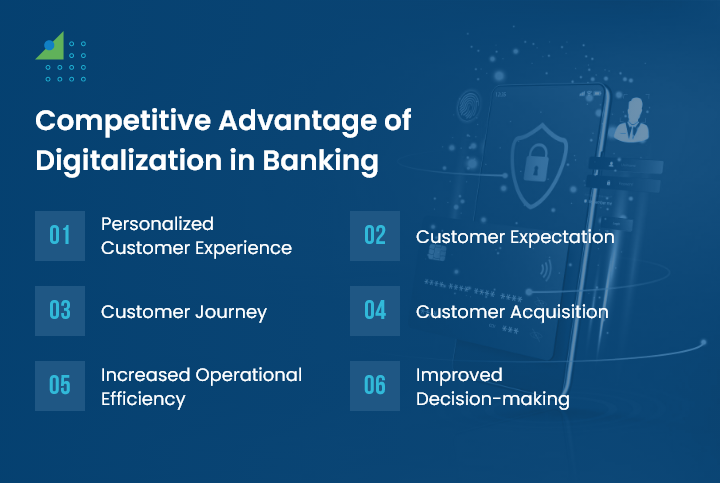With a steady expansion, the rise of digital transformation in banking has been nothing less than revolutionary.
As time moved fast, we have left the traditional banking system way behind and opted for its digital solutions as an alternative.
The businesses that could not adapt to this digital era have been left behind in the competition and long forgotten by the users or are now investing in fintech development service provider to win this race.
Looking at the data given by prominent companies, it is clear that digital banking systems will grow in the coming times.
We can visualize this through the stat by Business Wire, which describes that 61% of consumers indicate their likelihood of switching to a digital-only bank.
Hence, now is the time to rely on intelligent technologies and innovations to cope with this shift.
When it comes to large-scale projects revolutionizing industry sectors like Retail, Healthcare, Banking, or Finance with robust digital solutions, they may not go as smoothly as expected.
As a result, ever-growing enterprises hire a reputable digital transformation company to gain a competitive edge. They can also hire an in-house specialist to help with their digital transformation journey. However, when hiring this specialist, they should ask them to make a good cover letter outlining why they are the best fit for the role and how they can contribute to the company’s success.
However, despite all the efforts, the journey to digital transformation can be full of challenges and barriers that we will discuss in this blog. Also, we will explain how businesses can tackle them effectively.
Digital Transformation in Banking Explained
With Digital Transformation can explore the new opportunities, various industries adapt to the latest technologies, services, and trends to keep pace with the latest changes happening in the digital landscape.
However, the question remains: what does it mean by digital transformation in the Finance sector?
By referring to the definition, digital transformation in banking concerns the gradual shift to digital services and online banking services.
This also entails the multiple backend technologies and changes required to support this transformation.
With the effective support and coordination of digital-native solutions, the banks can seamlessly integrate multiple digital initiatives.
The modernization of banks has been brought on by the digitization of banking services.
Digital transformation has changed the way banks interact with their customers and deliver services.
In today’s world, modern banks are expected to provide new tools and use updated technology to enhance customer experience both internally and externally.
With the increasing digital services offered by modern banks, there is a significant amount of data being collected.
Moreover, as the banking industry evolves, it’s essential to recognize how technology has changed the banking industry, enabling more secure, efficient, and customer-friendly banking experiences.
To ensure the security and compliance of these burgeoning digital operations, the adoption of regtech in banking is becoming increasingly essential, providing streamlined regulatory processes and enhanced risk management.
This has led to modern banks adopting new operating models and infrastructure such as AI, ML, IoT, blockchain, cloud computing and APIs to manage and utilize this data efficiently.
Incorporating robust AML screening processes is essential in this context, ensuring compliance with regulatory requirements and enhancing the security of digital banking operations.
Moreover, banking sectors can implement a top-down approach to align the strategy with overarching goals.
At the same time, integrating digital systems, platforms, and infrastructure for strategic and personalized customer experience.
Key Factor of Digital Transformation in Banking
Digital transformation in banking is a complex process that involves several key factors. One of the key factors is the shift towards digital banking from traditional methods.
This requires banks to modernize their infrastructure and operating models to leverage the power of data analytics and meet the demands of customers.
However, it’s crucial for banks to balance digital innovation with the needs of all customers, who still prefer brick-and-mortar branches.
To remain competitive in a digitally-driven market, banks must fully embrace digital transformation and implement digital technologies that enhance customer experience and streamline operations.
What are the Benefits of Digital Transformation in Banking and Finance?
Do you know? The number of digital banking users in the United States is expected to grow from 2021 to 2025, and is expected to reach 217 million by 2025.
Also, take a look at the banks transitioning towards innovative digital solutions.
Revolut, Square, Nubank, Monzo, and Tangerine are well-known digital banks nowadays in countries like the USA, Canada, the UK, and others investing in digital transformation.
But why is it that so many banks are investing in digital transformation? That’s because they are getting multiple whooping advantages.
Below are the listed benefits banks can leverage from successfully transforming into digital businesses.
Digital banking transformation is the incorporation of digital technologies into banking services to improve customer experience and operational efficiency.
It includes online banking applications, data encryption software, virtual assistants, KYC system software, website availability and optimization, etc.
As per a study by Statista, 2.5 billion individuals are predicted to utilize online banking services by the year 2024.
However, it is important to note that digital tech cannot wholly replace traditional banking interactions like face-to-face discussions for personal loans and mortgages.
Digital banking transformation can complement these traditional interactions to enhance customer experience and operational efficiency in a rapidly changing financial data ecosystem.
Competitive Advantage of Digitalization in Banking
Digital transformation has become a necessity for banks that want to stay competitive in the market.
With the rise of new and innovative business models, competitive advantage is no longer solely based on size but speed and agility.
By embracing digital technologies, banks can gain a competitive advantage by streamlining their operations, improving customer experience, and staying ahead of the curve.
To achieve this advantage, banks need to think outside the box and adopt new strategies that leverage the power of technology.
1. Personalized Customer Experience
Various industries, including banking and finance, focus on customer experience in digital transformation.
Tech-savvy customers expect brands to be ahead of their competitors regarding technical expertise and user flow.
Throughout the time customers stay on the banking application and interact with it, it should deliver consistent and personalized experiences.
This will drive a high engagement rate and ensure a consistent experience across platforms.
2. Customer Expectation
Digital transformation in banking has become essential as customer expectations continue to evolve.
With the rise of personalized, seamless experiences, banks need to prioritize customer-centric design and leverage relationship management systems for deep insight into customer needs and preferences.
The expectations set by digitally optimized services like Amazon, Uber and Netflix have also raised the bar for fast, streamlined services from banks.
It is imperative that banks embrace digital transformation to meet these expectations and stay competitive in today’s market.
3. Customer Journey
Digital transformation in banking involves digitizing the customer journey. Banks need to focus on designing holistic digital experiences that span across multiple functions and channels, including prospecting, sales, onboarding, and customer service experiences.
By systematically reinforcing internal capabilities and investing in new capabilities only when necessary for a specific customer journey, banks can achieve end-to-end enablement much faster.
The customer journey should be based on customer needs, desires, and behaviors rather than individual touchpoints.
Leading banks are already implementing these strategies to provide their customers with seamless and personalized digital banking experiences.
4. Customer Acquisition
Digital transformation is crucial for banks to stay competitive in today’s market. One of the benefits of a successful digital transformation is customer acquisition.
Banks can acquire more customers by offering convenient and personalized digital services that meet customer needs.
However, customer acquisition in the digital world also comes with challenges such as security and privacy concerns.
Nonetheless, with the right strategy and approach, banks can overcome these challenges and achieve higher customer acquisition rates.
5. Increased Operational Efficiency
With the right tools and technologies, your digital solution providers can automate manual tasks to streamline operations.
Moreover, automating tasks can reduce errors and, at the same time, enable your team to collaborate with each other seamlessly.
If you have to manage the whole banking application smoothly, then this must be your concern, as well as how to facilitate better connectivity between operational tasks.
The adoption of cloud-based solutions can be a revolutionary step in your digital journey since such initiatives also save time and costs, ultimately increasing profits.
Digital transformation efforts are critical for banks to keep up with the digital age.
With manual operations and legacy systems, it is challenging for banks to quickly implement changes and innovate in ways that increase productivity and efficiency.
Attracting and retaining customers is a key driver of digital transformation efforts, according to a survey conducted by American Banker.
Banks should measure the success of their digital transformation efforts by collecting data on key performance indicators such as return on digital investments, which measures the value provided by individual priority digital initiatives and their support of strategic organizational goals.
6. Improved Decision-making
When it comes to leveraging digital transformation services, many businesses implement technologies like artificial intelligence, machine learning, big data, cloud, AR/VR, and IoT, often seeking data warehousing consulting services to optimize and manage these technologies effectively.
Use cases of such intelligent technologies help them gain insights into customer behavior, assisting them in the decision-making process.
Moreover, AI-based analysis can help customers make faster trading decisions in capital markets.
Additionally, more calculative insights can lead to effective business decision strategies for businesses and designing a customer-centric banking application.
What are the Top 5 Barriers to Digital Transformation in Banking Sectors?
With so many benefits coming on the way, is digital transformation the need of the hour for the banking sector?
If so, why do so many businesses fail despite having the budget to implement technology solutions?
That’s because they do not comprehend the complexities and challenges of digitalization in the banking industry.
Here are some of the challenges banks can face in their digital transformation journey, and as a responsible business owner, you can avoid them.
Mobile banking has become an integral part of the digital banking journey.
With the shift from traditional to digital platforms, mobile applications and websites have become crucial for customers to perform their banking transactions.
Customers can access and manage their bank accounts and finances online through mobile banking applications, making it more convenient for them.
The banking industry has adapted to the digital age by providing faster and easier online payments options such as instant money transfers.
A digital ecosystem including mobile banking apps, online banking portals, chatbots, etc., creates a seamless and efficient customer banking experience.
1. Inadequate Estimation of Complexity and Cost
In order to establish an effective digital strategy, businesses begin with having a clear understanding of their requirements and cost estimation.
For precise planning, calculate the costs incurred over the project timeline.
This will ensure a comprehensive understanding of the overall impact of digital transformation on your banking app solutions.
Moreover, do not underestimate the complexities of the banking sector when it comes to transforming your traditional solutions digitally.
Most businesses fail because of extending the timeline of the digitalization initiatives, as this increases the original estimated project cost.
This can lead businesses to make changes in the required scope, which may offer the desired results.
2. Overlooking Technical Debt
Technology is becoming the core driver of value for businesses with modernized IT solutions in the banking sector.
However, a pitfall businesses need to avoid is tech debt.
It refers to the Off-balance sheet (OBS) requirements that need to be considered in the future.
Tasks or factors like clearing up old and outdated systems, resolving challenges hiding in infrastructure, or clearing unused applications can go unnoticed in the initial cost estimation.
However, the complications generated through the legacy technologies can hinder the effectiveness and efficiency of your new systems.
Therefore, businesses investing in digital transformation for banking must address these issues to avoid falling into the trap of tech debt.
Digital tools are becoming increasingly important in the banking industry to keep up with the digital transformation.
Banks need to review their current digital tools and capabilities to improve their online presence and customer experience.
Understanding concepts like open banking can further enhance their strategies in adapting to this evolving landscape.
Without digital tools, banks are spending large amounts of money on manual business processes for account opening and customer verification.
Automation of these processes is necessary to increase productivity and efficiency in the banking sector.
The implementation of digital tools will help banks keep up with the rapidly changing digital landscape and provide better services to customers.
3. Unable to Measure the Impact of Digital Transformation
The more effectively you will be able to measure the project requirements, the more efficiently you will be able to deliver the valuable results expected from the digital journey.
Therefore, carefully assess the current state and identify critical impact metrics.
This will help you track the impact during and after the transformation, helping you leverage all the benefits of your efforts.
In the banking industry, businesses may encounter challenges in quantifying and monitoring the impact of digital transformation accurately.
Thus, their strategy fails to establish seamless connectivity between the initiatives taken and the profitability and revenue growth.
Moreover, the lack of well-defined success metrics, failure to consider potential adverse effects on customer satisfaction, and disengagement of the end-users are also factors contributing to this ineffectiveness.
Digital transformation in banking is driven by the increasing usage of smart devices, connectivity, and the demand for high user experience.
Banks need to focus on creating user-friendly interfaces that are easy to navigate and provide a seamless experience for customers.
They can use design thinking principles to create user-centered designs that meet their customer’s needs and preferences.
Orchestration solutions can improve the efficacy and efficiency of risk management along digital user journeys, delivering a more dynamic user experience.
Banks must implement journey-time orchestration capabilities to reduce complexity and mitigate risks.
4. Not Rolling Out Smart Features Fastly Enough
Most of the banks fall behind their competitors in terms of innovation, productivity, and speed.
This means that companies may not be catering to the demands of end users in terms of resolving queries and releasing updates to tap into the potential of innovation in digital transformation.
A successful digital bank (fintech and neobank) rolls out new product with digital features and updates often, mostly every two to four weeks on average.
On the other hand, traditional banks are unable to keep up with this pace and have product rollout cycles of four to six months.
Hence, avoid being tangled up in traditional operating models and limited adoption of the agile method of managing a project.
Additionally, it is essential to rectify the underlying cultural barriers to boost the speed of their product deployment. This brings us to the last obstacle to overcome.
Digital transformation in banking has brought about a lot of change, especially with the rise of digital wallets.
These wallets allow customers to make payments easily and quickly, whether it’s in stores or online.
Banks are now embracing digital wallets as a way to improve customer centricity and expand their user base.
This digital transformation also provides security through transparency, which benefits both banks and their customers.
In addition, white labeling fintech solutions offer companies the ability to provide digital wallets under their brand name while leveraging on another company’s technology stack.
The digital wallets are the next step for contactless payments, making them an area to watch over the next few years.
5. The Quest of Searching for a Technology-driven Digital Transformation Company
For a thriving digital transformation approach, close collaboration and coordination across the organization are essential.
For banks working on traditional methods, priorities may be misaligned or conflicting, and there may be a lack of clarity in the execution process.
Therefore, having a digital transformation company as a technology partner can help them with better efficiency gains and researched digital solutions.
If you want to hire a fintech app company that has strong technical expertise and follows agile project management methodologies, you can choose to outsource your requirements.
With that, you get to work with talented professionals having expertise in specific areas like fintech application and robust digital banking applications.
With their assistance, you can take a holistic approach to digital transformation and refine your banking operations seamlessly.
Digital transformation in banking is all about embracing new technologies to meet the demands of the digital age.
The shift to offering online and digital services has become crucial for banks of all sizes.
Mobile banking has emerged as a crucial part of the digital banking journey, enabling traditional banks to keep up with the market changes.
Additionally, as cryptocurrencies like Litecoin gain popularity, integrating LTC to USD conversion tools can provide customers with seamless digital transaction capabilities and enhance their banking experience.
To stay competitive, banks need to adapt to new technologies and operating models that can help them throughout the entire customer’s journey.
Overall, digital transformation in banking is an ongoing process that seeks to reshape the financial services landscape by adopting innovative business models and customer-centric approaches.
Security Threats
Digital transformation in banking has its own set of security threats that need to be addressed.
With the increasing use of technology, cyber threats such as data breaches and online identity fraud have become major concerns.
Implementing security measures to protect customer data privacy is crucial for banks to maintain their reputation and ensure trust among customers.
The current pandemic crisis has further highlighted the need for strong security measures as more remote experiences put immense pressure on technological capabilities and open up new security threats.
Banks must prioritize security when undergoing digital transformation to ensure the safety of their customers’ information.
Conclusion
For banking leaders to address these challenges requires end-to-end technical support across business, architecture, and operational models.
With customer-centric digital transformation services, you can tackle a number of challenges, including lack of investment banking, competent personnel, and synergy among employees.
Digital transformation is key to the survival of large financial institutions in today’s fast-paced and ever-changing world.
By adopting new technologies, large financial institutions can streamline their operations, enhance customer experience, and stay competitive.
Banks that have embraced digital transformation have seen significant growth in revenue and profitability while improving customer satisfaction.
However, it is essential to ensure that regulatory guidelines and risk management are taken into account during the transformation process.
Large financial institutions can benefit from drawing on the expertise of FinTech Development Companies and regulatory agencies to ensure a successful digital transformation.
Besides, one of the challenges you must overcome is to train your workforce to accept and stay updated with this transformation.
When you become an agent of change and convince other stakeholders to do the same, you will be able to revamp your core banking system.
At the same, time, you will be able to overhaul your conventional project with smoother and more competent operations.
Therefore, digital transformation is a critical necessity to reduce costs, enhance productivity, and improve customer experience.
This way, you can stay relevant in the competitive market in the future.
FAQs
The challenges include legacy system integration, cybersecurity concerns, cultural resistance to change, regulatory compliance issues, and the need for upskilling the workforce to handle new technologies.
Cybersecurity concerns involve the increased risk of cyber threats and data breaches as banks adopt digital channels. Ensuring the security of customer data, implementing robust cybersecurity measures, and staying compliant with regulations become critical challenges.







